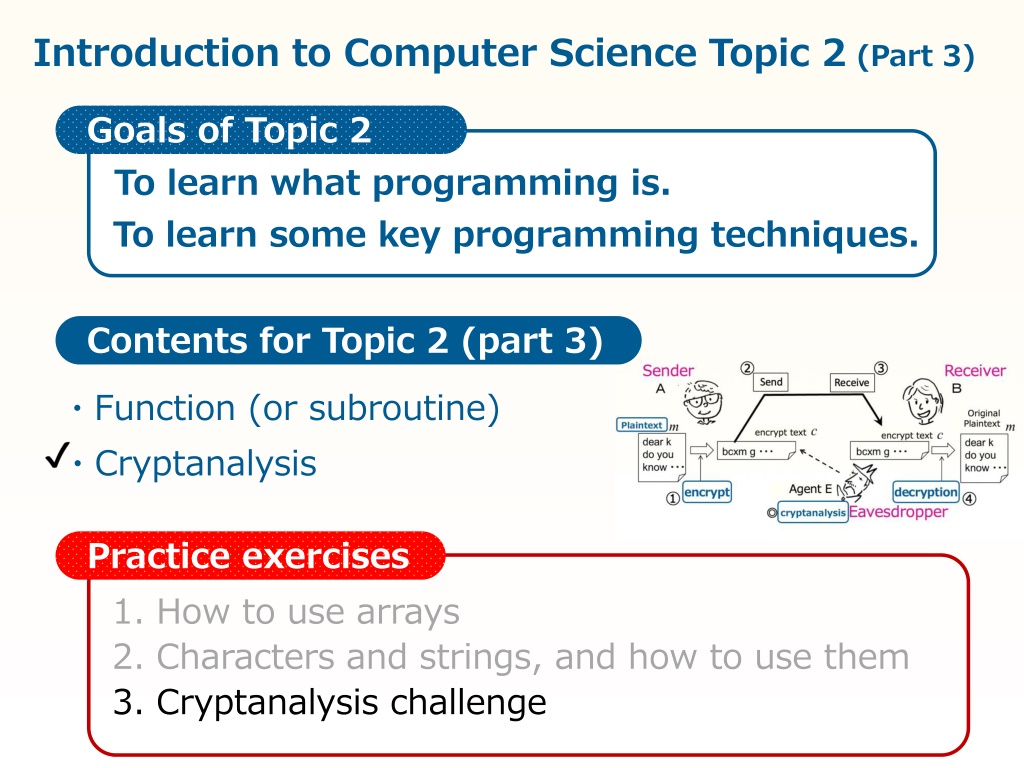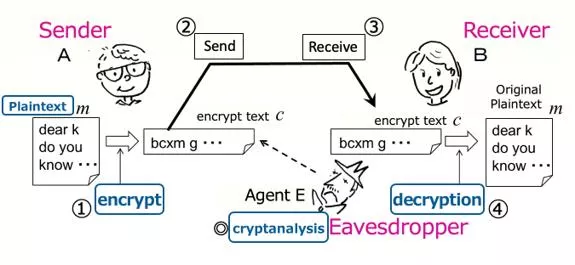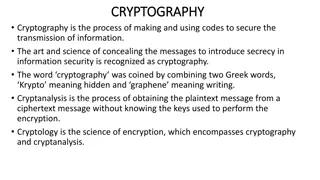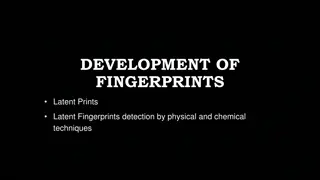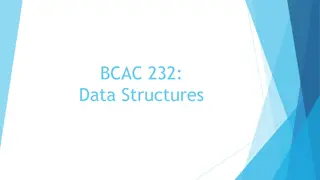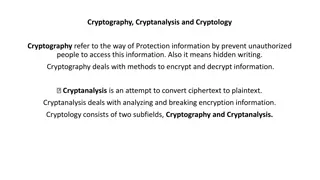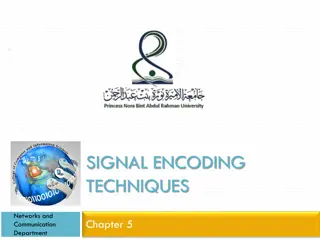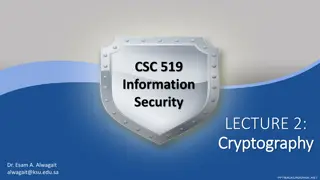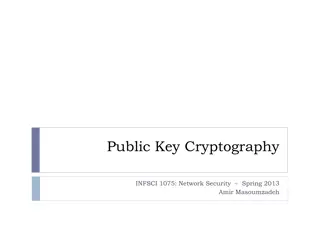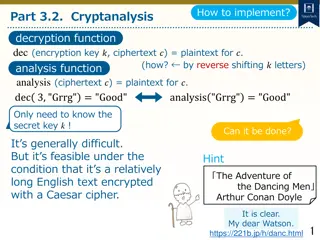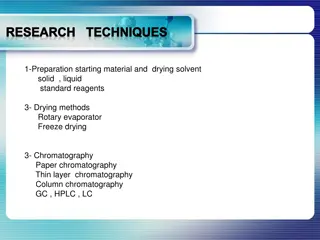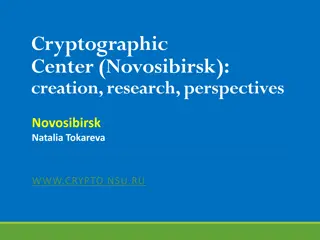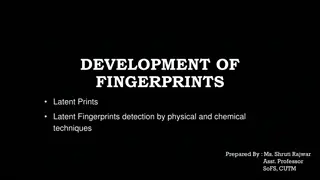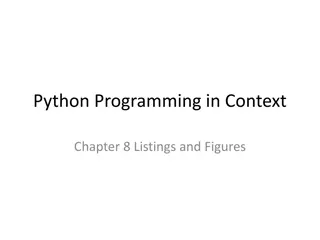Cryptanalysis: Key Concepts and Techniques
Cryptanalysis is a fundamental aspect of cryptography that involves decoding encrypted communications and messages. This topic delves into the basic cryptographic tools, such as the Caesar cipher, and explores how encryption and decryption functions work. By understanding cryptanalysis, you can analyze and break encrypted codes to reveal hidden information.
Download Presentation

Please find below an Image/Link to download the presentation.
The content on the website is provided AS IS for your information and personal use only. It may not be sold, licensed, or shared on other websites without obtaining consent from the author.If you encounter any issues during the download, it is possible that the publisher has removed the file from their server.
You are allowed to download the files provided on this website for personal or commercial use, subject to the condition that they are used lawfully. All files are the property of their respective owners.
The content on the website is provided AS IS for your information and personal use only. It may not be sold, licensed, or shared on other websites without obtaining consent from the author.
E N D
Presentation Transcript
Introduction to Computer Science Topic 2 (Part 3) Goals of Topic 2 To learn what programming is. To learn some key programming techniques. Contents for Topic 2 (part 3) Function (or subroutine) Cryptanalysis Practice exercises 1. How to use arrays 2. Characters and strings, and how to use them 3. Cryptanalysis challenge
What is cryptography? Part 3.2. Cryptanalysis Cryptography or cryptographic communication refers to communication encoded in such a way that you can t tell what the content of a communication text is even if you see it. Basic flow of cryptographic communication Cryptography is not only for communication; for example, we may use it when storing data. 2
Let's define the basic cryptographic tools as functions. Part 3.2. Cryptanalysis Caesar cipher encryption function enc (encryption key ?, plaintext ?) = ciphertext for ? (obtained by shifting ? letters). decryption function dec (encryption key ?, ciphertext ?) = plaintext for ? (obtained by reverse shifting ? letters). 3
What is cryptanalysis? Part 3.2. Cryptanalysis Cryptography or cryptographic communication refers to communication encoded in such a way that you can t tell what the content of a communication text is even if you see it. Basic flow of cryptographic communication 4
Let's define the basic cryptographic tools as functions. Part 3.2. Cryptanalysis Caesar cipher encryption function enc (encryption key ?, plaintext ?) = ciphertext for ? (obtained by shifting ? letters). decryption function dec (encryption key ?, ciphertext ?) = plaintext for ? (obtained by reverse shifting ? letters). analysis function analysis (ciphertext ?) = plaintext for ?. 5
Let's define the basic cryptographic tools as functions. Part 3.2. Cryptanalysis Caesar cipher Example encryption function enc (encryption key ?, plaintext ?) = ciphertext for ? (obtained by shifting ? letters). enc 3,"Good" = "Grrg" decryption function dec (encryption key ?, ciphertext ?) = plaintext for ? (obtained by reverse shifting ? letters). dec 3, "Grrg" = "Good" analysis function analysis (ciphertext ?) = plaintext for ?. analysis "Grrg" = "Good" 6
How to implement? Part 3.2. Cryptanalysis Example $ ruby encrypt.rb God Gvk $ Encryption program encrypt.rb def enc(k, m) Creating a ciphertext c return c end #### program body##### k = 7 plaintext = gets.chomp ciphertext = enc(k, plaintext) puts(ciphertext) enc.rb from Part 3.1 What we want Input plaintext Function enc generates ciphertext Output ciphertext 7
How to implement? Part 3.2. Cryptanalysis Decryption program decrypt.rb Encryption program encrypt.rb def dec(k, c) Converting to a plaintext m def enc(k, m) Creating a ciphertext c return m end #### program body##### k = 7 ciphertext = gets.chomp plaintext = dec(k, ciphertext) puts(plaintext) return c end #### program body##### k = 7 plaintext = gets.chomp ciphertext = enc(k, plaintext) puts(ciphertext) Let s consider !! 8
How to implement? Part 3.2. Cryptanalysis Decryption program decrypt.rb Encryption program encrypt.rb def dec(k, c) Converting to a plaintext m def enc(k, m) Creating a ciphertext c return m end #### program body##### k = 7 ciphertext = gets.chomp plaintext = dec(k, ciphertext) puts(plaintext) return c end #### program body##### k = 7 plaintext = gets.chomp ciphertext = enc(k, plaintext) puts(ciphertext) On the PC of Sender A $ ruby encrypt.rb < message.txt > cryptomessage.txt $ $ ruby decrypt.rb < cryptomessage.txt This is a test message. Hello, everyone! How is the class? Are you enjoying this on-line lecture? On the PC of Receiver B 9
How to implement? Part 3.2. Cryptanalysis Let s consider !! Complete the definition of subroutine dec for decryption. def enc(k, m) # prepare code_a = 97 leng = m.length # compute ciphertext a = m.unpack("C*") b = Array.new(leng) for i in 0..(leng-1) dist = a[i] - code_a if 0 <= dist && dist <= 25 b[i] = code_a + ((dist + k)%26)) else b[i] = a[i] end end c = b.pack( C* ) return c end hint: subroutine enc 10
How to implement? Part 3.2. Cryptanalysis Let s consider !! Complete the definition of subroutine dec for decryption. def dec(k, c) # prepare code_a = 97 leng = c.length # compute ciphertext a = c.unpack("C*") b = Array.new(leng) for i in 0..(leng-1) dist = a[i] - code_a if 0 <= dist && dist <= 25 b[i] = else b[i] = a[i] end end m = b.pack( C* ) return m end b[i] = code_a + ((dist + k)%26)) 11
How to implement? Part 3.2. Cryptanalysis Let s consider !! (use 15 min.) Let s consider !! Complete the definition of subroutine dec for decryption. def dec(k, c) # prepare code_a = 97 leng = c.length # compute ciphertext a = c.unpack("C*") b = Array.new(leng) for i in 0..(leng-1) dist = a[i] - code_a if 0 <= dist && dist <= 25 b[i] = else b[i] = a[i] end end m = b.pack( C* ) return m end Google form CSxxx_C3_12-Q2 https://forms.gle/a9TdHEr2kA3VwRj9A b[i] = code_a + ((dist + k)%26)) The Adventure of the Dancing Men Arthur Conan Doyle https://221b.jp/h/danc.html 13
